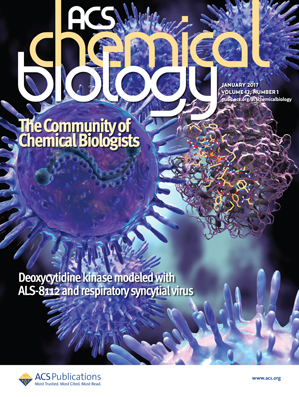8-氧基-7,8-二氢嘌呤作为增强氨基糖苷RNA适体选择性的构建块。
摘要
在其他应用中,核酸作为潜在的治疗工具、传感器或生物材料的使用急剧增加。其中,RNA适体因其对同源靶标(包括小分子、蛋白质、离子或细胞)的先天高特异性而备受关注。在这项工作中,我们利用8-氧-7,8-二氢鸟嘌呤(8-oxoG)参与独特的h键相互作用的能力,并探讨了它在增加/控制RNA和DNA适体的选择性/亲和力方面的作用。所选择的模型是一个23 nt长的RNA (Neo61/Neo1-5'-GGA CUG GGC GAG AAG UUU AGU CC)链,它折叠成一个五环发夹,在茎内有三个G·U摆动对,已知对各种氨基糖苷具有亲和力。8-OxoG在由RNA、DNA或2'-OMe修饰RNA组成的适体中掺入G6、G7、G10、G12或G15的位置。用氨基糖苷(x8)或抗生素(x1)骨架测试了它们对9个小分子靶点的识别,并通过圆二色性(CD)测定了它们的亲和力。等温滴定量热法(ITC)证实了CD是一种可靠的技术。结果表明,8-oxodG在DNA第12位(OG12-DNA)的掺入导致对新霉素或核糖素(Kd≈2.5 μM和2.2 μM)的选择性增加,与其他靶标相比,结合强度更强1-2个数量级。此外,6位8-oxodG (OG6-DNA)功能化显示出对新霉素或妥布霉素的选择性增加,尽管亲和度降低(Kd≈46和53 μM)。有趣的是,与RNA同源物相比,标准DNA适体对新霉素、核糖素和庆大霉素的选择性也提高了4-10倍。另一方面,相应的含有8-oxoG或其他修饰的RNA类似物,特别是8-氧苷、肌苷、8-氧腺苷或尿苷,导致对大多数氨基糖苷的高度乱交,卡那霉素和链霉素通常具有更高的解离常数。2'- ome修饰核糖的存在导致了与相应的规范RNA结构相似的趋势。从结构的角度来看,所有的核碱基修饰都会导致适体(包括DNA类似物)的热不稳定性,而2'-OMe核糖修饰的存在则会增加热稳定性。在测试的分子中,新霉素和核糖素诱导RNA或DNA适配体发生显著的结构变化(通过CD测量)。RNA的变化包括形成一个具有正椭圆度(λmax ~ 285 nm)的新带,这与糖基键沿着G·U摆动对旋转有关,这可能有助于识别。另一方面,规范和OG12 DNA适体的结合导致b到a形式的转变,其中较小的主槽可能有助于促进DNA-靶标相互作用。进一步的结构数据是通过在rna酶A、T1或dna酶I存在下进行结构探针分析获得的;它们表现出不同的降解模式,从而随着8-oxoG/8-oxodG的位置和小分子靶标的存在与否而改变二级结构。总的来说,本文报道的结果表明:(1)在DNA中使用8-oxodG增加了对新霉素和/或核糖素的适体选择性;(2) 8-氧鸟嘌呤的存在可以改变RNA和DNA的功能,具有广泛的生物学意义;(3)引入2'-OMe修饰并不影响本研究中适体的选择性。虽然预测8-oxoG将如何影响适配体的选择性还为时过早,但这项工作提供了氧化RNA的结构和功能之间的联系。The use of nucleic acids as potential therapeutic tools, sensors, or biomaterials, among other applications, has dramatically increased. Among these, RNA aptamers are of interest due to an innate high specificity toward their cognate targets, which include small molecules, proteins, ions, or cells. In this work, we took advantage of the ability that 8-oxo-7,8-dihydroguanine (8-oxoG) has to participate in unique H-bonding interactions, and probed its use to increase/control the selectivity/affinity of aptamers of RNA and DNA. The chosen model is a 23-nt long RNA (Neo61/Neo1–5′-GGA CUG GGC GAG AAG UUU AGU CC) strand that folds into a pentaloop hairpin with a stretch of three G·U Wobble pairs within the stem, which is known to have affinity toward various aminoglycosides. 8-OxoG was incorporated at positions G6, G7, G10, G12, or G15, within aptamers composed of RNA, DNA, or 2’-OMe modified RNA. Their recognition was tested toward 9 small molecule targets with aminoglycoside (x8) or antibiotic (x1) backbones, and their affinities were measured via circular dichroism (CD). Isothermal titration calorimetry (ITC) was used to corroborate the use of CD as a reliable technique. It was determined that incorporation of 8-oxodG at position-12 within DNA (OG12-DNA) led to increased selectivity toward neomycin or ribostamycin (Kd ≈ 2.5 and 2.2 μM), displaying 1–2 orders of magnitude tighter binding compared to other targets. Furthermore, functionalization with 8-oxodG at position-6 (OG6-DNA) displayed increased selectivity toward neomycin or tobramycin, albeit with decreased affinities (Kd ≈ 46 and 53 μM). Interestingly, the canonical DNA aptamer also displayed 4–10 fold enhanced selectivity toward neomycin, ribostamycin, and gentamicin, compared to its RNA homologue. On the other hand, the corresponding RNA analogues containing 8-oxoG or other modifications, specifically 8-oxoinosine, inosine, 8-oxoadenosine, or uridine, resulted in a high level of promiscuity toward most aminoglycosides, with kanamycin and streptomycin generally exhibiting higher dissociation constants. The presence of 2’-OMe-modified ribose led to trends similar to those obtained with their corresponding canonical RNA constructs. From a structural perspective, all nucleobase modifications led to thermal destabilization of the aptamer (including the DNA analogues), while the presence of the 2’-OMe ribose modification resulted in increased thermal stability. Among the molecules tested, neomycin and ribostamycin induced significant structural changes (measured via CD) on aptamers of RNA or DNA. Changes in RNA included the formation of a new band with positive ellipticity (λmax ∼ 285 nm), associated with glycosyl bond rotation along the G·U wobble pairs that presumably facilitates recognition. On the other hand, binding by canonical and OG12 DNA aptamers resulted in a B-to-A form transition, where the smaller major groove may serve to facilitate DNA-target interaction. Further structural data were obtained by carrying out structural probing assays in the presence of RNase A, T1, or DNase I; which displayed varying degradation patterns and thus changes in secondary structure as a function of the position of 8-oxoG/8-oxodG and presence/absence of the small-molecule target. Overall, the results reported herein show that (1) the use of 8-oxodG within DNA increases aptamer selectivity toward neomycin and/or ribostamycin; (2) the presence of 8-oxoguanine can alter the function of RNA and DNA, which is of broad biological relevance; and (3) the introduction of 2’-OMe modifications does not affect the selectivity of the aptamers in this work. While it is early to predict how 8-oxoG will affect the selectivity of aptamers at large, this work provides a link between the structure and function of oxidized RNA.

 求助内容:
求助内容: 应助结果提醒方式:
应助结果提醒方式:


